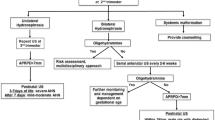Abstract
The issue of antenatal hydronephrosis has become a routine component for the care of a pregnant woman despite limited evidence of a clinical benefit. The genitourinary tract represents the most commonly detected organ system with identified abnormalities, with antenatal hydronephrosis (ANH), being the most notable and common finding. ANH represents a spectrum, with most cases being a trivial and inconsequential finding on maternal fetal ultrasound. However, there is a correlation with increased grades of ANH being associated with increased severity of urinary tract pathology. Most patients can be managed expectantly with appropriate evaluation commenced postnatally based on severity of ANH and proper parental counseling and education. The purpose of this review was to assess current literature and guidelines pertaining to ANH and incorporate our practical interpretations of their significance.

Similar content being viewed by others
References
Mallik M, Watson AR (2008) Antenatally detected urinary tract abnormalities: more detection but less action. Pediatr Nephrol 23:897
Nguyen HT, Herndon CD, Cooper C et al (2010) The Society for Fetal Urology consensus statement on the evaluation and management of antenatal hydronephrosis. J Pediatr Urol 6:212–231
Ismaili K, Avni FE, Piepsz A et al (2004) Current management of infants with fetal renal pelvis dilation: a survey by French-speaking pediatric nephrologists and urologists. Pediatr Nephrol 19:966
Ismaili K, Hall M, Donner C et al (2003) Results of systematic screening for minor degrees of fetal renal pelvis dilatation in an unselected population. Am J Obstet Gynecol 188:242
Coplen DE, Austin PF, Yan Y et al (2006) The magnitude of fetal renal pelvic dilatation can identify obstructive postnatal hydronephrosis, and direct postnatal evaluation and management. J Urol 176:724
Lee RS, Cendron M, Kinnamon DD et al (2006) Antenatal hydronephrosis as a predictor of postnatal outcome: a meta-analysis. Pediatrics 118:586
Harrison MR, Golbus MS, Filly RA et al (1987) Fetal hydronephrosis: selection and surgical repair. J Pediatr Surg 22:556
Harrison MR, Golbus MS, Filly RA et al (1982) Fetal surgery for congenital hydronephrosis. N Engl J Med 306:591
Harrison MR, Golbus MS, Filly RA et al (1982) Management of the fetus with congenital hydronephrosis. J Pediatr Surg 17:728
Harrison MR, Nakayama DK, Noall R et al (1982) Correction of congenital hydronephrosis in utero II. Decompression reverses the effects of obstruction on the fetal lung and urinary tract. J Pediatr Surg 17:965
Dhillon HK (1998) Prenatally diagnosed hydronephrosis: the Great Ormond Street experience. Br J Urol 81(Suppl 2):39
Thomas DF (2010) Prenatal diagnosis: what do we know of long-term outcomes? J Pediatr Urol 6:204
Ulman I, Jayanthi VR, Koff SA (2000) The long-term followup of newborns with severe unilateral hydronephrosis initially treated nonoperatively. J Urol 164:1101
Ismaili K, Hall M, Piepsz A et al (2006) Primary vesicoureteral reflux detected in neonates with a history of fetal renal pelvis dilatation: a prospective clinical and imaging study. J Pediatr 148:222
Psooy K, Pike J (2009) Investigation and management of antenatally detected hydronephrosis. Can Urol Assoc J 3:69
Walsh TJ, Hsieh S, Grady R et al (2007) Antenatal hydronephrosis and the risk of pyelonephritis hospitalization during the first year of life. Urology 69:970
Coelho GM, Bouzada MC, Lemos GS et al (2008) Risk factors for urinary tract infection in children with prenatal renal pelvic dilatation. J Urol 179:284
Lee JH, Choi HS, Kim JK et al (2008) Nonrefluxing neonatal hydronephrosis and the risk of urinary tract infection. J Urol 179:1524
Estrada CR, Peters CA, Retik AB et al (2009) Vesicoureteral reflux and urinary tract infection in children with a history of prenatal hydronephrosis—should voiding cystourethrography be performed in cases of postnatally persistent grade II hydronephrosis? J Urol 181:801
Roth CC, Hubanks JM, Bright BC et al (2009) Occurrence of urinary tract infection in children with significant upper urinary tract obstruction. Urology 73:74
Circumcision policy statement (2012) American Academy of Pediatrics Task Force on Circumcision. Pediatrics 130:585–586
Mukherjee S, Joshi A, Carroll D et al (2009) What is the effect of circumcision on risk of urinary tract infection in boys with posterior urethral valves? J Pediatr Surg 44:417
Herndon CD, McKenna PH, Kolon TF et al (1999) A multicenter outcomes analysis of patients with neonatal reflux presenting with prenatal hydronephrosis. J Urol 162:1203
Ismaili K, Avni FE, Wissing KM et al (2004) Long-term clinical outcome of infants with mild and moderate fetal pyelectasis: validation of neonatal ultrasound as a screening tool to detect significant nephrouropathies. J Pediatr 144:759
Ismaili K, Avni FE, Alexander M et al (2005) Routine voiding cystourethrography is of no value in neonates with unilateral multicystic dysplastic kidney. J Pediatr 146:759
Roth JA, Diamond DA (2001) Prenatal hydronephrosis. Curr Opin Pediatr 13:138
Chung S, Majd M, Rushton HG et al (1993) Diuretic renography in the evaluation of neonatal hydronephrosis: is it reliable? J Urol 150:765
Ross SS, Kardos S, Krill A et al (2011) Observation of infants with SFU grades 3–4 hydronephrosis: worsening drainage with serial diuresis renography indicates surgical intervention and helps prevent loss of renal function. J Pediatr Urol 7:266–271
Author information
Authors and Affiliations
Corresponding author
Rights and permissions
About this article
Cite this article
Davenport, M.T., Merguerian, P.A. & Koyle, M. Antenatally diagnosed hydronephrosis: current postnatal management. Pediatr Surg Int 29, 207–214 (2013). https://doi.org/10.1007/s00383-012-3258-4
Accepted:
Published:
Issue Date:
DOI: https://doi.org/10.1007/s00383-012-3258-4




